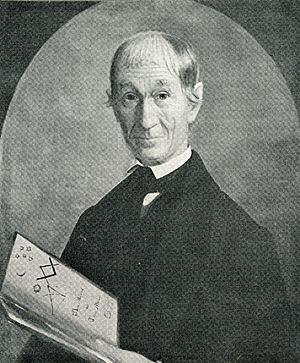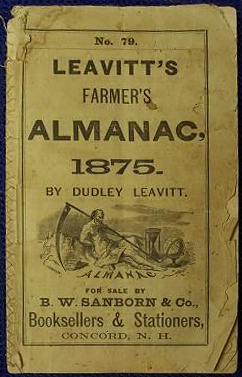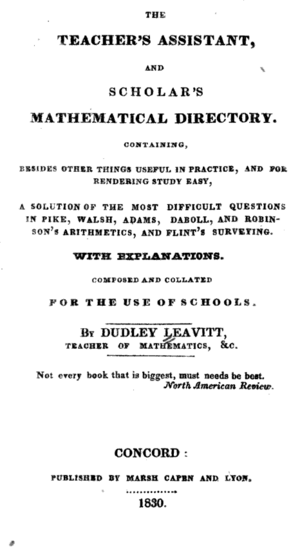Dudley Leavitt (publisher) facts for kids
Quick facts for kids
Dudley Leavitt
|
|
|---|---|

Leavitt in 1849
|
|
| Born | 1772 Exeter, New Hampshire |
| Died | September 20, 1851 (aged 78–79) Meredith, New Hampshire |
| Occupation | Teacher, mathematician, writer, publisher |
| Education | Phillips Exeter Academy |
| Notable works | Leavitt's Farmers Almanack |
| Spouse | Judith Glidden |
|
|
|
Dudley Leavitt (1772 – September 20, 1851) was an American publisher and a very smart person. He was one of the first students to graduate from Phillips Exeter Academy in his hometown of Exeter, New Hampshire. Later, he moved to Gilmanton, where he worked as a newspaper editor and a teacher.
A few years later, Leavitt moved to Meredith. There, besides teaching and farming, he started publishing Leavitt's Farmers Almanack in 1797. This was one of the first farmer's almanacs in the United States. Dudley Leavitt was a polymath, meaning he knew a lot about many different subjects. He used his knowledge of math, languages, and astronomy to create these very popular almanacs. They were so successful that they continued to be published until 1896, long after he passed away.
The first almanac in 1797 was called The New England Calendar: Or, Almanack for the Year of Our Lord 1797. It said it was "Calculated for the Meridian of Concord" but would work for any of the New England States.
Contents
Dudley Leavitt's Early Life and Career
Dudley Leavitt was born in Exeter. He was the oldest child of Joshua Leavitt, a farmer, and Elizabeth James. He was named after Governor Thomas Dudley, an early governor of Massachusetts. Dudley's father moved to Deerfield when Dudley was young.
Dudley went to Phillips Exeter Academy and graduated in 1790. In 1794, he married Judith Glidden from Gilmanton. They settled there, where Dudley had family. In Gilmanton, Leavitt studied Latin and Greek with Rev. Isaac Smith. He also served as a selectman (a local government official) for the town in 1802.
Leavitt's Love for Math and Science
Dudley Leavitt loved mathematics and astronomy the most. He was a true scientist and wrote scientific papers throughout his life, often about astronomy and physics. He even presented his findings at the annual meetings of the American Philosophical Society. For example, in 1811, he wrote a paper about astronomy for the American Academy of Arts and Sciences. In it, he shared a "New and short Method of calculating the times of the First and Last Quarters of the Moon."
To earn more money, Leavitt also taught school. In 1800, he started the Gilmanton Gazette, a local weekly newspaper. He also ran the Farmer's Weekly Magazine for two years with a partner. His newspaper business didn't last, but he was one of the first people to publish newspapers in New Hampshire. The printing presses he used were later bought by the Concord Gazette in 1806.
Moving to Meredith and Starting a School
In 1819, Leavitt and his wife moved to Meredith. He opened a school called the "Meredith Academick School." He advertised that the school would teach many subjects. He promised to make learning "easy and pleasant" for his students.
The cost for board was $3.00 per quarter. This covered most subjects. For more advanced topics like Algebra, Navigation, and Astronomy, there was an extra charge of 50 cents per quarter. In Meredith, people knew him as "Old Master Leavitt."
Leavitt lived on his farm near Center Harbor, close to Lake Winnipesaukee, where he held his classes. He was known as a strict teacher but also had a fun side. He would hand-paint "Award of Merit" panels for students who met his high standards. Leavitt taught school even into his 70s. Many successful men in New Hampshire were proud to say they had been taught by him.
When he wasn't teaching, he was farming his 50-acre farm or studying. People told stories about how focused he was on reading or studying, often not noticing anything else around him. He wasn't just a scholar; he also raised cattle and worked hard on his farm.
The Rise of Leavitt's Farmer's Almanack

Dudley Leavitt's love for learning, his experience with newspapers, and his work writing textbooks led him to create his farmer's almanac. He started publishing it while still living in Gilmanton. From the beginning, his almanac showed his common sense and a clever sense of humor. For example, in an early edition, he included a drawing of a New Hampshire person battling the cold weather. He quoted a poem about the harsh winters, which many people in the "Granite State" (New Hampshire) could relate to.
Leavitt continued to publish his almanac after moving to Meredith. He had also started a newspaper in 1811 called The New Hampshire Register, which he published for several years (1811–17). The Register became famous because Leavitt included short summaries of historical events. Besides farming, teaching, and publishing his newspaper, Leavitt wrote and published at least eight textbooks. These books covered math, grammar, astronomy, geography, and music. Some popular ones included The Scholar's Review and Teacher's Daily Assistant.
The Almanac Becomes a Huge Success
The almanac, which he called Leavitt's Farmers' Almanack and Miscellaneous Yearbook, became incredibly popular. Eventually, Leavitt stopped many of his other activities to focus on it. By 1846, Leavitt's almanacs were selling about 60,000 copies a year. This was a huge number for that time!
Leavitt understood that the weather was a very important topic for New Englanders, especially because of his interest in astronomy. His almanac, with its focus on astronomy and crops, was like an early "Weather Channel." He paid close attention to unusual weather. For example, during the very cold summer of 1816, when crops froze in July, Leavitt thought sunspots might be the cause. Readers noticed that Leavitt paid attention and offered explanations, which made the almanac even more popular.
Eventually, people knew the schoolteacher and farmer as "Leavitt the almanac-maker." By 1824, the almanacs even carried his name, called Leavitt's New-England Farmer's Almanack. Dudley Leavitt became quite famous in his time. Joseph Walker, one of his biographers, said that Leavitt was "probably known to more persons in New Hampshire than any other man."
People even pointed out his house to travelers as belonging to a very famous person. Henry McFarland, who worked for a printer who published Leavitt's almanacs, remembered him as a "courtly man with gentle manners."
Leavitt's almanacs gave tips on everything from farming to weather to astronomy. They became a regular part of life throughout the region. They were sold in general stores, and later in grocery stores and drug stores. His nephew, William B. Leavitt, an astronomer, helped him with some of the calculations for the farming tips.
The almanac continued to provide detailed observations of nature. For example, the entry for September 6, 1881 (published after his death), described "Yellow Day." This was a day when the sky turned a peculiar yellow color across New England, making it dark and confusing animals.
Dudley Leavitt's Death and Lasting Legacy
Dudley Leavitt passed away at his farm in Meredith on September 20, 1851. When he died, he had already finished writing and calculating the next issue of his almanac, plus five more years' worth of issues! This was very impressive to other writers and printers.
The New York Times even reported his death. They noted that "Dudley Leavitt, the veteran almanac maker, died this morning. His age was 80." Leavitt was buried in a private burial ground on his family farm. His beloved almanac, which he did all the work for, continued to be published in Concord until 1896. This was 45 years after he died! His nephew, William B. Leavitt, took over editing the publication.
A New Hampshire historical marker (number 7) in Center Harbor remembers Leavitt. It says his publication "provided information vital to domestic and agricultural life of the period." His almanac was one of the longest-running publications of its kind in the nation's history. The Old Farmer's Almanac, which started five years before Leavitt's, was his main competitor. It is still published today, making it the oldest continuously published magazine in North America.
The New Hampshire Historical Society in Concord has a painting of Dudley Leavitt. Local citizens helped buy it, including former Governor Charles H. Bell. Leavitt and his wife had 11 children. Two of their children married Congregational missionaries who went to Thailand.
Images for kids




